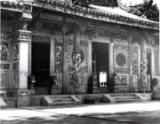
Kheng Hock Keong Temple
Encyclopedia
Kheng Hock Keong Temple , located on the corner of Sintodan Street and Strand Road in Latha Township
, Yangon
(Rangoon), Burma (Myanmar), is the largest and oldest Chinese
Buddhist and Taoist
temple dedicated to the Chinese goddess Mazu
in Yangon. It was originally built as a wooden temple in 1861 and completed in 1863. A new brick building was completed in 1903, costing over 153,000 rupees. Kheng Hock Keong is maintained by a Hokkien Chinese
clan association. The temple attracts mostly Hokkien and Hakka
worshipers, while the other temple in Latha Township, called the Guanyin Gumiao Temple
, attracts Cantonese
worshipers.
Latha Township
Latha Township is located in the western part of downtown Yangon, and shares borders with Lanmadaw township in the west, Pabedan township in the east, Seikkan township and Yangon river in the south, and Dagon township in the north. It consists of ten wards and is home to three primary schools, one...
, Yangon
Yangon
Yangon is a former capital of Burma and the capital of Yangon Region . Although the military government has officially relocated the capital to Naypyidaw since March 2006, Yangon, with a population of over four million, continues to be the country's largest city and the most important commercial...
(Rangoon), Burma (Myanmar), is the largest and oldest Chinese
Overseas Chinese
Overseas Chinese are people of Chinese birth or descent who live outside the Greater China Area . People of partial Chinese ancestry living outside the Greater China Area may also consider themselves Overseas Chinese....
Buddhist and Taoist
Taoism
Taoism refers to a philosophical or religious tradition in which the basic concept is to establish harmony with the Tao , which is the mechanism of everything that exists...
temple dedicated to the Chinese goddess Mazu
Mazu
Mazu may refer to the following Chinese topics:* Mazu , deity in South China and Taiwan* Mazu Daoyi , Zen teacher in medieval China* Matsu Islands, administrative region of the Republic of China...
in Yangon. It was originally built as a wooden temple in 1861 and completed in 1863. A new brick building was completed in 1903, costing over 153,000 rupees. Kheng Hock Keong is maintained by a Hokkien Chinese
Burmese Chinese
The Burmese Chinese or Chinese Burmese are a group of overseas Chinese born or raised in Burma . Although the Chinese officially make up three percent of the population, the actual figure is believed to be much higher...
clan association. The temple attracts mostly Hokkien and Hakka
Hakka people
The Hakka , sometimes Hakka Han, are Han Chinese who speak the Hakka language and have links to the provincial areas of Guangdong, Jiangxi, Guangxi, Sichuan, Hunan and Fujian in China....
worshipers, while the other temple in Latha Township, called the Guanyin Gumiao Temple
Guanyin Gumiao Temple
Guanyin Gumiao Temple is one of two major Chinese temples located in Latha Township in Yangon's Chinatown. It was founded by the Cantonese community of Yangon in 1823, but was destroyed by a fire in December I855, and subsequently rebuilt in 1864, with two additional brick buildings to the side...
, attracts Cantonese
Cantonese people
The Cantonese people are Han people whose ancestral homes are in Guangdong, China. The term "Cantonese people" would then be synonymous with the Bun Dei sub-ethnic group, and is sometimes known as Gwong Fu Jan for this narrower definition...
worshipers.
Gallery
See also
- Fushan Si TempleFushan Si TempleFushan Si Temple , located on Kaba Aye Pagoda Road in Bahan Township, Yangon, is a Hokkien Chinese temple founded in January 1875 by overseas Chinese with ancestry from Anxi County in Fujian Province. The temple is managed by the Kheng Hock Keong Temple in downtown Yangon. Fushan Si is dedicated to...
- Guanyin Gumiao TempleGuanyin Gumiao TempleGuanyin Gumiao Temple is one of two major Chinese temples located in Latha Township in Yangon's Chinatown. It was founded by the Cantonese community of Yangon in 1823, but was destroyed by a fire in December I855, and subsequently rebuilt in 1864, with two additional brick buildings to the side...
- Long Shan Tang TempleLong Shan Tang TempleLong Shan Tang Temple is a Hokkien Chinese clan temple located on Anawrahta Road in Latha Township, part of Yangon's Chinatown. It was founded by members of the Tseng and Khoo clans from Fujian province in 1877. The temple is dedicated to ancestor worship.-See also:*Fushan Si Temple*Guanyin...

